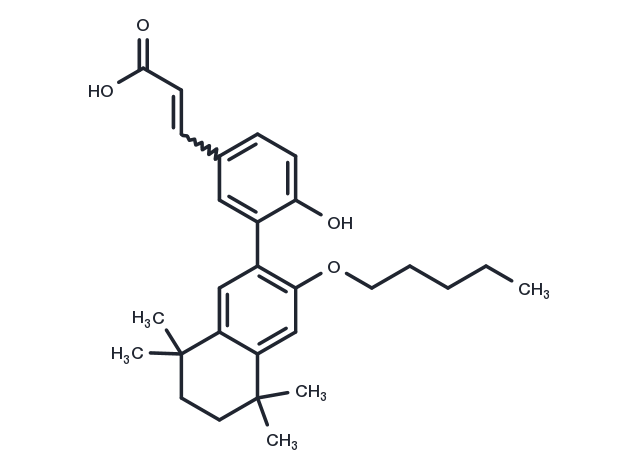Powder: -20°C for 3 years | In solvent: -80°C for 1 year


UVI 3003 is a highly selective antagonist of the retinoid X receptor. UVI 3003 inhibits Xenopus and human RXRα in Cos7 cells (IC50s: 0.22 and 0.24 μM, respectively).

| Pack Size | Availability | Price/USD | Quantity |
|---|---|---|---|
| 1 mg | In stock | $ 30.00 | |
| 2 mg | In stock | $ 44.00 | |
| 5 mg | In stock | $ 68.00 | |
| 10 mg | In stock | $ 122.00 | |
| 25 mg | In stock | $ 255.00 | |
| 50 mg | In stock | $ 428.00 | |
| 100 mg | In stock | $ 639.00 | |
| 1 mL * 10 mM (in DMSO) | In stock | $ 78.00 |


| Description | UVI 3003 is a highly selective antagonist of the retinoid X receptor. UVI 3003 inhibits Xenopus and human RXRα in Cos7 cells (IC50s: 0.22 and 0.24 μM, respectively). |
| Targets&IC50 | RXRα:0.22 μM(Xenopus RXRα, in Cos7 cells), RXRα:0.24 μM(Human RXRα, in Cos7 cells) |
| In vitro | UVI3003 fully activates xPPARγ (EC50: 12.6 μM) and is almost completely inactive on hPPARγ and mPPARγ. UVI 3003 causes a 65.4% difference in EECD34 cell fusion and desmin expression. UVI 3003 (10 μM) does not change the proliferation rate of extraocular muscles (EOM)-derived or LEG-derived EECD34 cells [1][2]. |
| Molecular Weight | 436.58 |
| Formula | C28H36O4 |
| CAS No. | 847239-17-2 |
Powder: -20°C for 3 years | In solvent: -80°C for 1 year
DMSO: 100 mg/mL (229.05 mM), Sonification is recommended.
You can also refer to dose conversion for different animals. More
bottom
Please see Inhibitor Handling Instructions for more frequently ask questions. Topics include: how to prepare stock solutions, how to store products, and cautions on cell-based assays & animal experiments, etc.
UVI 3003 847239-17-2 Autophagy Metabolism Retinoid Receptor UVI3003 Retinoid X receptors RAR/RXR UVI-3003 Inhibitor Retinoic acid receptors inhibit inhibitor
